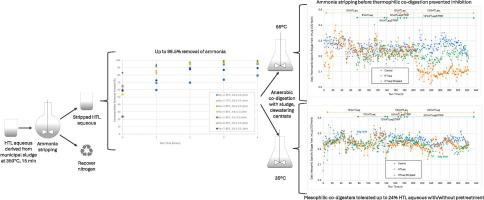当前位置:
X-MOL 学术
›
Chem. Eng. J.
›
论文详情
Our official English website, www.x-mol.net, welcomes your
feedback! (Note: you will need to create a separate account there.)
Ammonia recovery via stripping from hydrothermal liquefaction aqueous from sludge for anaerobic co-digestion pretreatment
Chemical Engineering Journal ( IF 13.3 ) Pub Date : 2024-07-10 , DOI: 10.1016/j.cej.2024.153715 Alison E Cox , Cigdem Eskicioglu
Chemical Engineering Journal ( IF 13.3 ) Pub Date : 2024-07-10 , DOI: 10.1016/j.cej.2024.153715 Alison E Cox , Cigdem Eskicioglu

|
Hydrothermal liquefaction (HTL) is a thermo-chemical method of processing wastewater solids that could be preferential over anaerobic digestion (AD) because it produces a greatly reduced volume of solids. Instead, the effluent can be separated into biocrude refined into fuel, hydrochar a carbon-rich solid and HTL aqueous waste. Unfortunately, HTL aqueous is high in ammonia, phenolics, and nitrogen heterocyclic compounds that can inhibit AD if used for treatment. Ammonia stripping was tested for pretreatment of HTL aqueous from dewatered mixed sludge at 350 °C, 15 min and recovering ammonia. Seven stripping reactor conditions were run, and the best results were seen at 85 °C, a pH of 9.3 and 500 mL/min air flow rate. This case achieved ammonia and total phenolic compounds removal of 79.5 ± 0.1 and 32 ± 1 %, respectively, in 4 h. The ammonia stripping was coupled with acid adsorption to produce an ammonium sulphate salt with fertilizer value. The ideal ammonia stripping conditions produced a salt with a purity of 98.0 ± 0.05 % and represented an ammonia recovery of 73.9 ± 0.04 %. Semi-continuous flow bench-scale thermophilic anaerobic co-digestion of HTL aqueous with municipal sludge found that 12 % of influent chemical oxygen demand (COD) can come from HTL aqueous without inhibition if pretreated with ammonia stripping, while the digester fed with a similar COD from non-pretreated HTL aqueous showed inhibition. Under mesophilic conditions, semi-continuous flow anaerobic co-digestion was successful for non-pretreated and pretreated HTL aqueous even with 24 % and 22 % of influent COD provided by HTL aqueous, respectively.
中文翻译:

通过从污泥中的水热液化水汽提回收氨用于厌氧共消化预处理
水热液化(HTL)是一种处理废水固体的热化学方法,它比厌氧消化(AD)更有利,因为它产生的固体量大大减少。相反,废水可以分为精炼成燃料的生物原油、富含碳的固体氢炭和 HTL 含水废物。不幸的是,HTL 水溶液富含氨、酚类和氮杂环化合物,如果用于治疗,这些化合物可以抑制 AD。氨汽提试验用于对脱水混合污泥中的 HTL 水进行预处理,在 350 °C 下进行 15 分钟并回收氨。运行了 7 种汽提反应器条件,在 85 °C、pH 9.3 和 500 mL/min 空气流速下观察到最佳结果。该案例在 4 小时内实现了氨和总酚化合物的去除率分别为 79.5 ± 0.1 和 32 ± 1 %。氨汽提与酸吸附结合产生具有肥料价值的硫酸铵盐。理想的氨汽提条件产生的盐纯度为 98.0 ± 0.05 %,氨回收率为 73.9 ± 0.04 %。 HTL 水溶液与城市污泥的半连续流实验室规模高温厌氧共消化发现,如果经过氨汽提预处理,则 12% 的进水化学需氧量 (COD) 可以来自 HTL 水溶液,而无需抑制,而消化池则采用类似的进料未经预处理的 HTL 水溶液的 COD 显示出抑制作用。在中温条件下,半连续流厌氧共消化对于未经预处理和预处理的 HTL 水溶液来说是成功的,即使 HTL 水溶液提供的流入 COD 分别为 24% 和 22%。
更新日期:2024-07-10
中文翻译:

通过从污泥中的水热液化水汽提回收氨用于厌氧共消化预处理
水热液化(HTL)是一种处理废水固体的热化学方法,它比厌氧消化(AD)更有利,因为它产生的固体量大大减少。相反,废水可以分为精炼成燃料的生物原油、富含碳的固体氢炭和 HTL 含水废物。不幸的是,HTL 水溶液富含氨、酚类和氮杂环化合物,如果用于治疗,这些化合物可以抑制 AD。氨汽提试验用于对脱水混合污泥中的 HTL 水进行预处理,在 350 °C 下进行 15 分钟并回收氨。运行了 7 种汽提反应器条件,在 85 °C、pH 9.3 和 500 mL/min 空气流速下观察到最佳结果。该案例在 4 小时内实现了氨和总酚化合物的去除率分别为 79.5 ± 0.1 和 32 ± 1 %。氨汽提与酸吸附结合产生具有肥料价值的硫酸铵盐。理想的氨汽提条件产生的盐纯度为 98.0 ± 0.05 %,氨回收率为 73.9 ± 0.04 %。 HTL 水溶液与城市污泥的半连续流实验室规模高温厌氧共消化发现,如果经过氨汽提预处理,则 12% 的进水化学需氧量 (COD) 可以来自 HTL 水溶液,而无需抑制,而消化池则采用类似的进料未经预处理的 HTL 水溶液的 COD 显示出抑制作用。在中温条件下,半连续流厌氧共消化对于未经预处理和预处理的 HTL 水溶液来说是成功的,即使 HTL 水溶液提供的流入 COD 分别为 24% 和 22%。

















































 京公网安备 11010802027423号
京公网安备 11010802027423号